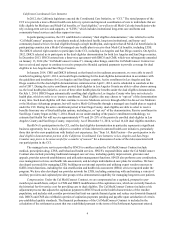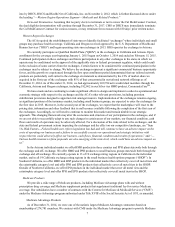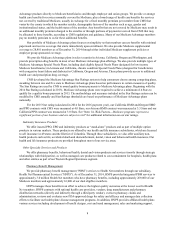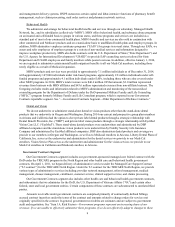Health Net 2014 Annual Report Download - page 18
Download and view the complete annual report
Please find page 18 of the 2014 Health Net annual report below. You can navigate through the pages in the report by either clicking on the pages listed below, or by using the keyword search tool below to find specific information within the annual report.16
strategic initiatives with respect thereto could adversely affect our business, cash flows, financial condition and results
of operations.”
Information Technology
Our business depends significantly on effective and efficient information systems. The information gathered and
processed by our information management systems assists us in, among other things, pricing our services, monitoring
utilization and other cost factors, processing provider claims, billing our customers on a timely basis, identifying
accounts for collection and detecting fraud, security threats and other risks. Our customers and providers also depend
upon our information systems for membership verification, claims status and other information. We have many different
information systems that support our various lines of business and we develop new systems as needed to keep pace with
continuing changes in technology and to support our operational needs, including potential business expansions. These
systems require the ongoing commitment of significant resources for continual maintenance, upgrading and
enhancement to meet our operational needs, evolving industry and regulatory standards, compliance with legal
requirements (such as the ACA and ICD-10 (as defined below) and changing customer preferences).
We have partnered with third parties to support our information technology systems and to help design, build,
test, implement and maintain our information management systems, and in November 2014 we announced the
Cognizant Transaction, which would significantly increase the scope of services provided to us by third parties, subject
to regulatory approval of the transaction. For additional information on the Cognizant transaction, see "—Cognizant
Transaction" and “Item 7. Management’s Discussion and Analysis of Financial Condition and Results of Operations.”
Our merger, acquisition and divestiture activity also requires transitions to or from, and the integration of, various
information management systems within our overall enterprise architecture.
CMS recently adopted a new coding set for diagnoses, commonly referred to as ICD-10, which significantly
expanded the number of codes utilized in claims processing. TheICD-10 coding set is currently required to be
implemented by October 2015. We incurred significant expenses in 2014 to implement and support the ICD-10 coding
set, and expect to incur incremental costs ahead of the required implementation date. In addition, our implementation
and support of the requirements of the ACA and the CCI, including the dual eligibles demonstration, have required, and
will continue to require the expenditure of significant resources as we continue to adapt to the changing guidance.
For additional information on our information technology and associated risks, see “Item 1A. Risk Factors—We
are subject to a number of risks in connection with our decision to enter into a master services agreement with
Cognizant for the performance of a significant portion of our business process and information technology activities,”
Item 1A. Risk Factors—If we fail to effectively maintain our information management systems, it could adversely affect
our business,” “Item 1A. Risk Factors—We are subject to risks associated with outsourcing services and functions to
third parties” and “Item 1A. Risk Factors—If we or our business associates that handle certain information on our
behalf fail to comply with requirements relating to patient privacy and information security, among other things, our
reputation and business operations could be materially adversely affected.”
Medical Management
We believe that managing health care costs is an essential function for a managed care company. Among the
medical management techniques we utilize to contain the growth of health care costs are pre-authorization or
certification for certain outpatient services and inpatient hospitalizations and a concurrent review of active inpatient
hospital stays and discharge planning. We believe that this authorization process, along with the inherent features of a
capitation payment model, helps to reduce inappropriate use of medical resources and achieve efficiencies in referring
cases to the most appropriate providers. We provide multiple models of care management and case management to our
members, and also contract with third parties to manage certain conditions such as neonatal intensive care unit
admissions and stays, as well as chronic conditions such as asthma, diabetes, chronic obstructive pulmonary disease,
coronary artery disease and congestive heart failure. These techniques are widely used in the managed care industry and
are accepted practices in the medical profession.
Accreditation
We pursue accreditation for certain of our health plans from the National Committee for Quality Assurance
(“NCQA”) and URAC. NCQA and URAC are independent, non-profit organizations that review and accredit HMOs
and other health care organizations. HMOs that apply for accreditation of particular product lines receive accreditation
if they comply with review requirements and quality standards. The Medicare line of business of our California HMO
has received NCQA accreditation with a score of “commendable.” HN California's commercial HMO/POS, HNL's PPO
and our Arizona HMO's commercial lines of business and HN California’s Medi-Cal line of business received NCQA
























